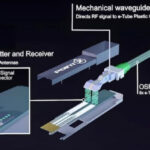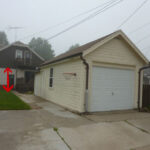If you’re planning to bring electricity from your house to a detached garage or outbuilding, one of the most important questions is: what type of wire should you use for an overhead connection?
The right wire type depends on your power requirements, installation distance, and local electrical codes — but generally, triplex service drop cable is the most common and reliable choice.
1. Understanding Overhead Power Runs
An overhead power run delivers electricity above ground, suspended between two structures — usually from your home’s service mast to a weatherhead on the garage.
This method is practical, cost-effective, and easy to inspect compared to underground wiring, which requires trenching.
Before installation, make sure to check NEC (National Electrical Code) and your local utility company requirements, as rules on clearances, conductor types, and grounding can vary by region.
2. The Best Type of Wire for Overhead Garage Power
Triplex Service Drop Cable (Most Common Choice)
For most residential applications, the best wire to run overhead to a garage is triplex service drop cable.
This cable consists of two insulated conductors (hot wires) and one bare neutral messenger, which also supports the cable mechanically.
Typical Voltage: 120/240V single-phase
Conductor Material: Aluminum (lightweight and cost-effective)
Common Sizes: #6 AWG to #2/0 AWG
Standards: ASTM B231/B232, IEC, or ANSI/ICEA S-76
Applications: Power supply to detached garages, barns, and small workshops
The messenger wire acts as both the neutral conductor and support strand, making triplex cable ideal for overhead spans up to 150 feet.
👉 Recommended Models:
AAC Triplex Service Drop Cable – for standard residential spans
AAAC or ACSR Triplex Cable – for longer spans or higher strength requirements
Quadruplex Service Drop Cable (for 3-Phase Loads)
If your detached garage or outbuilding requires three-phase power — common in commercial setups — use quadruplex service drop cable.
It includes three insulated phase conductors plus one bare neutral messenger.
Copper Conductors (Alternative for Short Runs)
Although aluminum triplex is standard, copper conductors such as THWN-2 or XHHW-2 can also be used if the span is short (under 30 feet) or if higher conductivity is needed.
Copper offers better flexibility and durability, but it’s heavier and more expensive, requiring additional support.
3. Sizing the Wire Correctly
Wire size depends on the distance to the garage and the amperage load you plan to draw.
Here’s a simplified guide for typical single-phase 240V setups:
| Load (Amps) | Distance (Feet) | Recommended Aluminum Size | Recommended Copper Size |
|---|---|---|---|
| 30A (lights, outlets) | up to 50 ft | #6 AWG | #8 AWG |
| 60A (small tools, welder) | 50–100 ft | #4 AWG | #6 AWG |
| 100A (heavy equipment) | 100–150 ft | #2 AWG | #4 AWG |
⚡ Always verify voltage drop and consult local code before final selection.
4. Overhead Wiring Requirements and Clearances
Safety clearances are critical for compliance and protection.
According to NEC 225.18 and 225.19, the minimum clearances for overhead wires are:
10 feet (3.0 m) above sidewalks and patios
12 feet (3.6 m) above residential driveways
18 feet (5.5 m) above public roads or streets
3 feet (0.9 m) horizontally from windows, doors, or balconies
Both the house and garage should have service masts equipped with weatherheads and drip loops to prevent moisture from entering the conduit.
5. Grounding and Connection
At the garage, connect the overhead service drop to a subpanel or disconnect switch.
Install a grounding electrode (ground rod) near the garage and bond it to the subpanel’s grounding bus using #6 AWG copper wire.
Proper grounding ensures safety and protection against lightning or short circuits.
6. Example Setup: Powering a Detached Garage
Here’s a typical setup for a 60A, 240V overhead feed to a garage located about 60 feet from the house:
Wire Type: Aluminum Triplex Service Drop Cable (#4 AWG)
Supports: Insulator hooks or service brackets on both structures
Height: Minimum 12 ft above driveway
Entry: Through a weatherhead and conduit into the garage subpanel
Grounding: One 8-ft ground rod bonded to the subpanel
This setup is cost-effective, compliant with NEC standards, and provides reliable power for lighting, outlets, and light-duty equipment.
7. Final Tips
Use outdoor-rated connectors and fittings only.
Avoid trees or sharp edges near the span.
If your overhead distance exceeds 150 ft, consider adding a mid-span pole or switching to underground cable.
When unsure, consult a licensed electrician before connecting to the main service.
Conclusion
For most homeowners and light commercial applications, the triplex aluminum service drop cable is the best and most economical wire to run overhead to a garage.
It’s durable, weather-resistant, and fully compliant with electrical codes when properly installed with weatherheads, grounding, and correct clearances.
If you require a longer span or heavier load capacity, consider AAAC, ACSR, or copper XHHW-2 cables depending on your project’s needs.
⚡ High-Quality Overhead Cables from TOT Wire & Cable
TOT Wire & Cable supplies a complete range of overhead electrical cables, including AAC, AAAC, ACSR, and triplex/quadruplex service drop cables — designed for safe and efficient power delivery to detached garages, barns, and workshops.
📞 Contact us today for expert guidance and a competitive quote on the best overhead wire for your installation.





